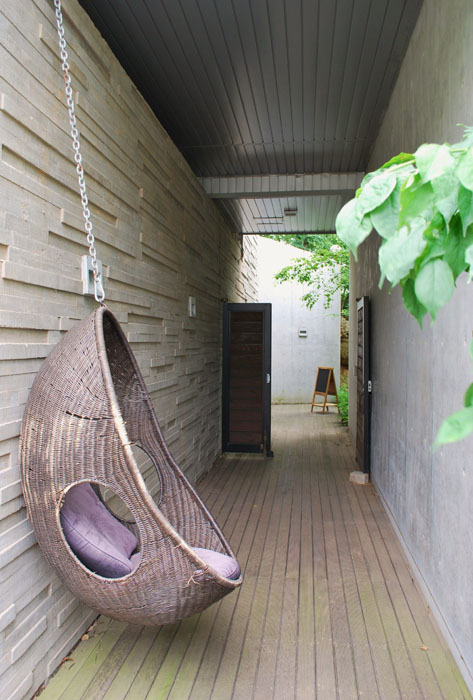Art Peninsula: Activity Below the Demilitarized Zone

PHOTOS BY JANET OH
The Heyri Art Valley is located in the town of Paju, just south of the Demilitarized Zone in South Korea, a mountainous landscape historically riddled with conflict. Though it is a repository for art objects, this is no place to be precious. And rather than draw borders, Heyri unifies artists, architects, and musicians in what strives to be a minimal-impact environment. The museums, galleries, concert halls, cafés, and residences merge with their natural surroundings, with no structures taller than three stories. An hour’s trek from Seoul by public transportation, Heyri is free to the public, although some galleries charge entry. I had the opportunity to spend a few hours one afternoon in Heyri Art Valley and visit select galleries:
Hangil Book House
A boxy structure comprised of narrow wooden strips and large windows, Book House serves multiple functions: restaurant, performance/exhibition hall, and reading space. Downstairs, large C-print photographs by Korean artist Kim Jung Man hang solemnly on white walls for the exhibition, “The Blossoms.” Roughly half the works depict flora in vibrant reds, yellows, and oranges. Aesthetically pleasing at first glance, these images prove to be provocative at second glance, as in the case of a close-up of a Venus flytrap resting inert but prepared. Opposite these color images hang a row of black and white images inclusive of their film edges, bearing the functionality of both camera apparatus and plant.
Gallery Hangil
When I entered this bi-level gallery, I was greeted with the quieting motet Pie Jesu. Perhaps it was excessive in light of the clearly religious references in the exhibition “The Forbidden,” a series of sculptures and photographs by Choi Eun-Kyung, on view until July 18. The upper level of the exhibition featured mostly silvery photographs of clouds overlaid with words like “trespasses” and “sin” whereas the lower level housed a line of Bible-like tomes called The Forbidden, pinned down by swords. Founded as part of the Book House complex, Hangil focuses on young, emerging voices in international contemporary art.
Art Factory
With titles like Unknown City #01 and Only Today #02, the photographs of Lee Sun-Ae rely more on visual cues than on description. Behind the blurry forms of city buses, cars, and people on the move are recognizable signs like KB, or Kookmin Bank, one of South Korea’s largest banks by asset. In Only Today #03, individuals lay leisurely by the Hangang, the river that runs centrally through Seoul. The photographs focus not on the faces of its inhabitants but on the places and emblems that characterize the modern metropolis.
Geumsan Gallery
What initially drew me to this gallery (pictured left) was the almost overlooked dynamism of the building. A tree’s branches literally grow out of square windows, as if the structure were built solely around this tree’s growth. Designed by architect Woo Kyung Kook, the entrance of Geumsan leads directly into a café next to an airy gallery space. “Light On” an exhibition of paintings by Im Sung-Yun, Jeong Bo Young, and Jeong Sae-Ra revolve around the theme of light. Street lamps float like out-of-focus orbs in Jeong Sae-Ra’s work, and a pair of paintings by Jeong BoYoung, titled “Vertical Time” and “Bright-Ladden Room,” depict a hollow room and the graceful play of low sunlight, contrasting artificial with natural light.
93 Museum
93 Museum is comprised of several rooms of works by Korean artists organized by theme. They include galleries of nudes, portraits, and works from the Modern period, such as a water drop painting distinctive of Informel painter Kim Tschang-yeul. Although the layout of the building proves disjoint, with a frenzy of trinkets and clothing for sale on the ground floor, the collection demonstrates the vast array of styles and approaches despite commonalities in subject matter. A performance space links the museum to another gallery and brings together artists and audiences outdoors, adhering to the idea of promoting a community near the sparse terrain dividing the Korean peninsula.






